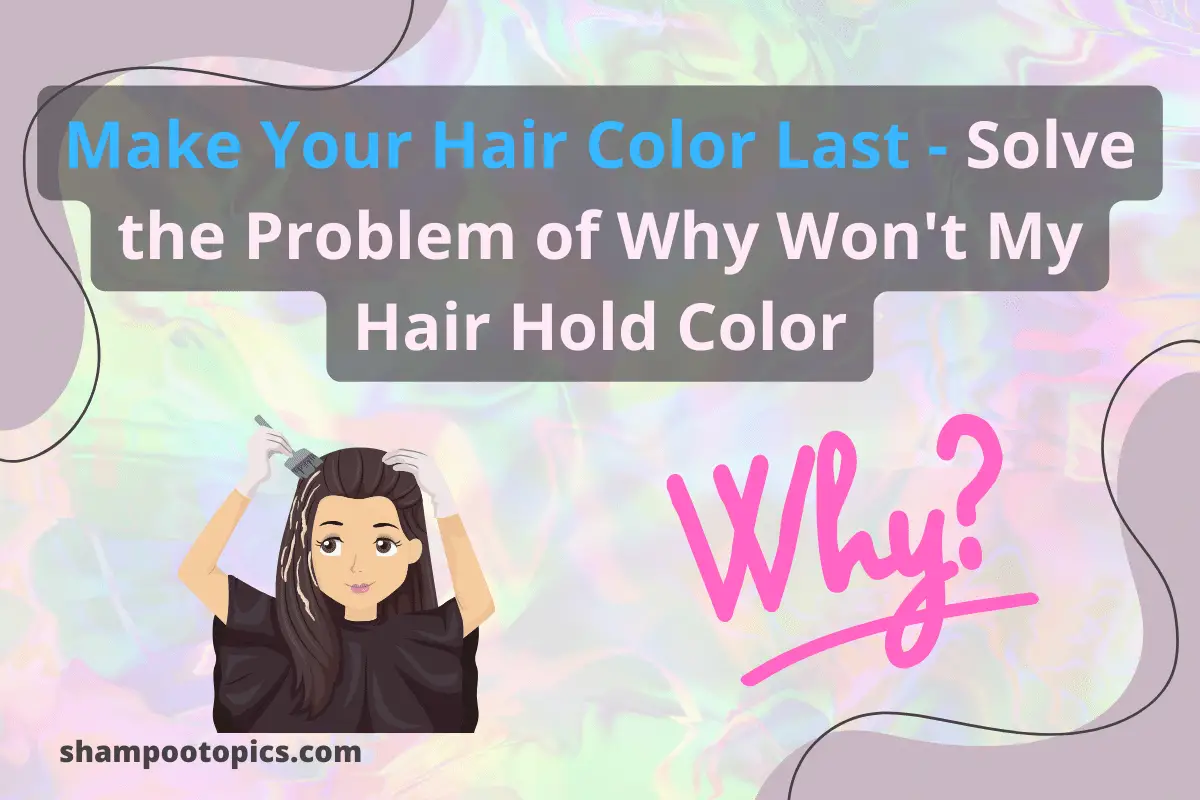I’m Amelia. I have been working with hair care product shampoo and conditioner for 6 long years. This website is...Read more

Are you tired of your gorgeous hair color fading too quickly or turning patchy just weeks after dyeing? Don’t worry; you’re not alone. Many people struggle with maintaining their hair color and often ask, “why won’t my hair hold color?” But with the right knowledge and techniques, you can keep your locks vibrant and beautiful for longer.
In this blog post, we’ll explore the reasons why hair doesn’t hold color, how to choose the right dye, and how to care for your colored hair to ensure it stays looking fresh and fabulous.
Table of Contents
Why Won’t My Hair Hold Color?
- Understand the causes of why hair color may fade quickly, such as hair porosity and incorrect dye application.
- Choose a suitable type of dye for your desired colour and hair type, taking into account developer strength.
- Adopt an appropriate routine to maintain vibrant colored
Reasons Your Hair Isn’t Holding Color

Believe it or not, there are various factors that contribute to your hair not holding color as long as you’d like. From hair porosity issues to incorrect dye application and external factors like hard water or sun exposure, these elements can make your hair color fade faster than expected.
Once you grasp these factors, you’ll be better equipped to help your hair retain dye and maintain its vibrancy longer.
We’ll delve into a detailed examination of these reasons.
Hair Porosity Issues
Hair porosity refers to the hair’s ability to absorb and retain moisture. If your hair has medium or high porosity, it struggles to retain moisture, causing hair color to fade more quickly. But how do you know if you have low porosity hair?
A simple test involves dropping a few strands of freshly washed, product-free virgin hair into a glass of room temperature water. Chances are you have low porosity hair if the strands stay on the surface of water after two to four minutes. For a precise assessment of your hair porosity, this test is recommended.
Low porosity hair has tightly closed cuticles, making it difficult for dye pigments to be absorbed, which can affect the results when dyeing any hair color, including pink hair.
Damaged hair, on the other hand, allows chemicals from the dye to penetrate hair cuticles unevenly, resulting in patchy or faded color. If you’re concerned about your hair’s porosity, it’s best to consult a professional hairstylist, as they can accurately assess your hair’s porosity and recommend the necessary steps to ensure successful coloring.
Incorrect Dye Application
Another reason for uneven or faded hair color is improper dye application, such as not using enough dye or not adhering to processing times. For a uniform color with permanent hair dye, thorough dye saturation in every strand is necessary to avoid patchy or faded color from insufficient dye application.
Ensure that the color is applied uniformly on the entire scalp. This will prevent any patchy discoloration or unevenness. Moreover, using an adequate amount of hair dye is crucial to cover the hair roots, shaft, and ends for the desired color.
External Factors
External factors like hard water, chlorine, and sun exposure can also negatively impact hair color retention. Hard water is abundant in dissolved minerals, such as calcium and magnesium, which can create a film that impedes color from reaching the hair.
Filtering hard water can enhance the health and appearance of hair and skin.
To protect your hair from these external factors, always use a clarifying shampoo to remove any build-up before coloring and follow up with hair care products specifically designed for color-treated hair.
Choosing the Right Hair Dye

Choosing the right hair dye is an essential step in ensuring your hair color lasts and looks vibrant. This involves understanding how hair dye work, the difference between permanent and semi-permanent dyes, as well as selecting the appropriate developer strength for your desired color and hair type.
We’ll examine these aspects to guide you in making an informed decision when selecting your hair dye.
Permanent vs. Semi-Permanent Dye
Permanent dyes penetrate the hair shaft and provide a longer-lasting color, while semi-permanent dyes form a coating on the hair shaft that gradually fades over time. Permanent hair dye offers benefits such as improved gray hair coverage, a large selection of color options, and potential hair strengthening.
However, it can also lead to more damage and quicker color fading.
On the other hand, semi-permanent hair dye is less damaging and offers a more natural-looking hue that gradually diminishes with time, making it a gentler option.
Understanding Developer Strength
Developer strength refers to the concentration of hydrogen peroxide in a hair color product, which activates the color molecules in the dye and facilitates its penetration into the hair shaft. The strength of the developer directly affects the intensity of the color and the degree of lightening.
A higher strength developer will produce more intense color and lightening, while a lower strength developer will produce less intense color and lightening.
To achieve the desired color and hair type, it’s crucial to choose the correct developer strength, ranging from low for subtle color changes to high for more pronounced color alterations.
Prepping Your Hair for Color

Proper preparation of your hair before coloring is fundamental in achieving the best results. This includes using clarifying and deep conditioning treatments to remove any build-up and nourish the hair, as well as trimming any damaged ends.
We’ll delve into these pre-coloring process procedures in more depth.
Clarifying and Deep Conditioning
Using a clarifying shampoo before coloring helps eliminate build-up and residue that could impact the color process, while deep conditioning treatments penetrate and nourish the hair. Clarifying shampoos remove product and hard water build-up that can hinder the adherence of hair dye.
Deep conditioning masks, on the other hand, nourish and hydrate the hair to ensure it is healthy and robust before coloring, allowing the color to last longer.
Trimming Damaged Ends
Trimming damaged ends is crucial for even color absorption and preventing further damage. Damaged hair has an uneven or bumpy texture and includes dryness, brittleness, dullness, breakage, and excessive hair loss.
To trim damaged ends, use sharp scissors to cut off the ends in small sections, starting at the bottom and gradually working up, removing only a minimal amount at a time. This process helps in maintaining the integrity of the remaining hair strands.
Prevent additional damage by applying a heat protectant before styling, avoiding excessive heat tool usage, and applying a deep conditioning treatment weekly.
Maintaining Colored Hair

Now that you’ve colored your hair, it’s time to focus on maintaining your gorgeous new hue. Proper maintenance is key to ensuring your hair color lasts and stays vibrant. We’ll cover the appropriate washing methods for colored hair and protection strategies against heat and sun damage in this segment.
Proper Washing Techniques
When it comes to washing colored hair, it’s essential to use a gentle, sulfate-free shampoo and conditioner, as these are specifically designed for color-treated hair. Also, wash your hair with cold water to prevent color fading.
It’s recommended to wash your hair every other day to avoid over washing, which can contribute to color fading.
Protecting Hair from Heat and Sun Damage
Protecting your hair from heat styling tools and sun exposure is crucial for maintaining your hair color. Use heat protectant sprays before using any heat styling tools, such as blow dryers or flat irons, to prevent damage.
Additionally, UV-blocking products should be employed to shield your hair from sun exposure, as UV rays can cause hair color to fade.
Fixing Faded or Patchy Color

If you’re dealing with faded or patchy hair color, there are solutions available to help refresh your look. Color-depositing products and professional color correction can both effectively address uneven color and restore vibrancy to your locks.
We’ll delve deeper into these alternatives.
Using Color-Depositing Products
Color-depositing products, such as shampoos, conditioners, and masks, are designed to deposit color into the hair, helping maintain, tone, and tint hair color at home. To use these products, select a product suitable for your hair color and follow the instructions on the packaging.
Generally, you should apply the product to damp hair, leave it on for the prescribed duration, and then rinse it out. However, be cautious not to use these products too frequently, as they can lead to buildup on the hair and an unnatural appearance.
Correcting Uneven Color
If you’re struggling with persistent uneven or patchy color, it’s best to consult a professional hairstylist for color correction. Professional color correction is a process where a variety of techniques are used to rectify uneven color and restore the hair’s original color.
Although it can be costly, professional color correction is often the most effective way to achieve the desired results.
To maintain your corrected color, continue using a color-safe shampoo and conditioner and apply a deep conditioning treatment once a week to keep your hair healthy and hydrated.
Preventing Future Hair Color Issues

Maintaining a consistent hair care routine and thoughtfully planning chemical treatments are key to avoiding future hair color complications. By prioritizing healthy hair and carefully scheduling treatments, you can ensure your color stays vibrant and your hair remains healthy.
Regular Hair Care Routine

Regular trims are essential for maintaining natural hair health and preventing split ends, while deep conditioning treatments with natural oils nourish and hydrate the hair cuticle, keeping it vibrant and healthy. Both of these treatments help deter fading of hair color.
Additionally, using a gentle, sulfate-free shampoo and conditioner specifically designed for color-treated hair will help protect your color and maintain its vibrancy.
Planning Chemical Treatments Wisely
When planning chemical treatments, such as perms or relaxers, it’s crucial to consider the timing in relation to hair coloring. Wait at least two weeks after coloring your hair before undergoing a chemical treatment, or if you plan on having a treatment, do so before coloring your hair.
After any chemical treatment, use a deep conditioner to help protect the hair from damage, and continue using a color-safe shampoo and conditioner to maintain the color.
Summary
In conclusion, maintaining vibrant and long-lasting hair color is achievable with a proper understanding of hair porosity, using the right hair dye, prepping your hair for color, and following a regular hair care routine.
By addressing the reasons behind fading and uneven color, choosing the right products, and protecting your hair from heat and sun damage, you can enjoy gorgeous, vibrant locks for longer. Remember, hair health is the foundation for beautiful, long-lasting color, so make it a priority and watch your hair flourish.
Frequently Asked Questions
How do I fix my hair that won’t hold color?
To fix your hair that won’t hold color, adding a clarifying shampoo or hair mask with Biotin Collagen and Keratin may help. Also, reviving your locks with targeted treatments before colouring is important. Finally, washing your hair with cool water and rinsing with cool water can help keep the dye fresh.
How can I make my hair hold color better?
To make your hair hold color better, deep condition it before and after dyeing, avoid using hot water when washing and opt for a sulfate-free shampoo, wait 72 hours to wash the hair after dying, only wash every 48 hours, and use coloured treatments to extend its life.
How can I find out if I have low porosity hair?
To test for low porosity hair, drop a few strands of freshly washed product-free hair into a glass of room temperature water. If the strands stay on the surface after two to four minutes, then you likely have low porosity hair.
What is the difference between permanent and semi-permanent hair dye?
Permanent hair dye penetrates the hair shaft, providing long-lasting color, whereas semi-permanent dye only coats the hair shaft and gradually fades over time.
How can I protect my hair from heat and sun damage?
Protect your hair from heat damage by using heat protectant sprays before styling and UV-blocking products to shield your hair from the sun.

I’m Amelia. I have been working with hair care product shampoo and conditioner for 6 long years. This website is an outlet of my deep passion for hair, Shampoo and Conditioner. Basically, I'm here to guide you on shampoo and conditioner.

